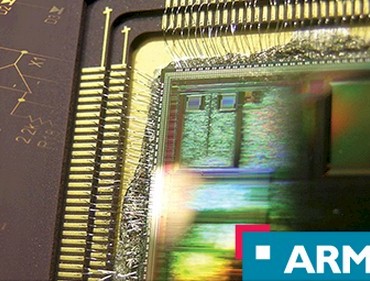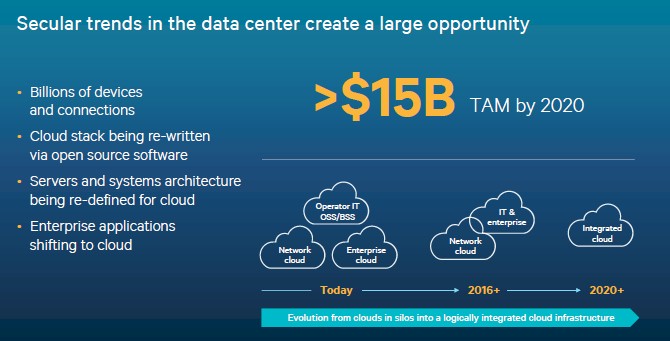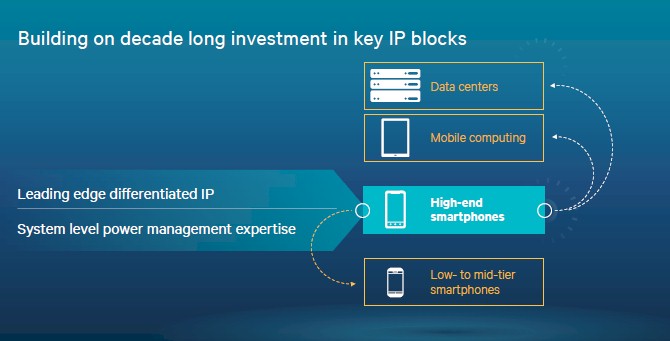Qualcomm To Storm The Datacenter With ARM Chips

The coming battle over compute in the datacenter pitting myriad ARM server chip makers against X86 processors is starting to shape up, with smartphone and tablet chip provider Qualcomm entering the ring after months of rumors. The chip company, which is one of the dominant suppliers of ARM chips in the world for client devices and for embedded uses such as automobiles and network devices, sees its push into the datacenter as not just inevitable, but natural.
When we say Qualcomm is one of many chip makers who want to take a bite out of the X86 processor market share in the datacenter, we really mean take a bite out of the Intel Xeon because the unit share of the Opterons from Advanced Micro Devices has fallen to only a few percent over the past several years. The Great Recession hit just as Intel was getting its Xeon act together and as AMD pulled back on its roadmap in the wake of bugs and delays with its "Barcelona" Opterons. AMD is getting ready to ship its own "Seattle" Opteron A Series chips any day now, with deliveries promised before the end of the year, and Applied Micro has its "Storm" X-Gene 1 chip out and the "Shadowcat" X-Gene 2 in the works for next year. Cavium is working on its ThunderX ARM chips for servers, and Broadcom is getting ready to forge its "Vulcan" processors. Texas Instruments has a hybrid ARM-DSP chip, and Marvell has 32-bit and 40-bit ARM server chips right now; both have not said what their 64-bit plans are, but if they want to stay in the game, they will need 64-bit processors for sure.
Broadcom and Cavium are shaping up to be credible threats to the 64-bit ARM server chips from AMD and Applied Micro products, and they are no doubt grateful that Nvidia decided to not go ahead with its hybrid "Denver" chips, which would have mixed a custom ARM CPU with an Nvidia GPU. Ditto for the relief all of the ARM server chip suppliers must have felt when Samsung, which never officially announced its intentions to enter the datacenter with an ARM server chip but was widely believed to be funding such a project, had a change of heart and decided to stay on the sidelines for now.
Each one of the ARM server chip suppliers brings some of its own assets to market, and significantly, all of them that are working on 64-bit ARMv8 designs are bringing to bear a significant level of expertise in networking. Broadcom is the market leader in merchant silicon for Ethernet switches, and Cavium and Applied Micro have played in different parts of the network stack, too. Cavium is a supplier of multicore processors that are used for high-bandwidth packet processing in network gear, and Applied Micro supplies many network equipment makers with various components. AMD has the SeaMicro fabric interconnect it acquired a few years back and should be leveraging this with its ARM chips. Marvell has switch chips that it integrates with its ARM chips.
As we have noted many times here at EnterpriseTech, the attack on incumbent systems almost always comes from below, with a technology that was not originally intended to come into the market being adapted by disruptors and then overtaking that market. The X86 chip designed for desktops was modified slightly so it could be used in servers more than two decades not to establish an X86 server market, but to do a better job tailoring chips to an existing market that was developing for systems based on desktop processors. Since that time, clusters of X86 servers have become the default data processing engines in the enterprise and have also become the main engines for massively parallel and shared memory systems in the supercomputer centers of the world. There are exceptions to this rule, of course, such as the IBM mainframe or RISC systems from IBM and Oracle.
Qualcomm made its ARM server intentions known at its analyst day conference in New York this week, and Steve Mollenkopf, CEO at the company, showed an evolutionary chart of the architecture of the datacenter that is familiar to those who track enterprise computing. The interesting bit is that Qualcomm is calling the end of the X86 era to coincide with the rise of the cloud era, where client devices are largely powered by ARM devices and that service providers, carriers, and son hyperscale datacenter operators will want to have the tools they use to design and test software on ARM client devices work on devices in the datacenter. They could adapt their tools to X86 processors, or they can hope that someone like Qualcomm creates server chips.
"Now we are at a point where a lot of the growth in the datacenter is happening in areas where the OS is being written from scratch on Linux and being driven by a small number of people who design their own datacenters and are interested in having alternatives and are interested in new architectures," explained Mollenkopf. "At the same time, if you look at Qualcomm's roadmap, the high-end of the smartphones and what will be the evolution of the laptop and the tablet really is starting to merge with what will be feasible to put into the datacenter."
Qualcomm, like many who observe the infrastructure business and its evolution, thinks that the systems that are being used by network carriers will start looking more and more like the enterprise clouds and network clouds, and that the total addressable market that it thinks it can target with a server variant of its Snapdragon ARM processor represents a more than $15 billion opportunity by 2020. At the moment, ARM servers are barely a blip in the $50 billion or so global market for systems, and if history is any guide, if there are benefits to using ARM servers, then the hyperscale and supercomputing communities will test the idea out first and then go in volume. Enterprises will follow suit, but as they did with the evolution of distributed applications running on Linux on clusters.
It is significant that Qualcomm showed a video during its analyst day when talking about its impending entry into the server racket that quoted Jay Parikh, vice president of infrastructure engineering at Facebook. The social network is one of the pioneers of hyperscale, and it is not afraid to use ARM as a lever to get what it wants out of Intel and perhaps out of a competing band of hungry ARM chip suppliers.
"We are always looking for opportunities to rethink how we build the underlying cloud infrastructure that powers our Facebook applications," Parikh said. "Technologies like ARM-based servers are really interesting because of the different characteristics they provide in terms of performance, power, and cooling. Qualcomm-based ARM servers gives us the ability to rethink the way we have built certain parts of our infrastructure."
It is also noteworthy that Satya Nadella, CEO at Microsoft, was quoted next in the presentation. Microsoft has a version of Windows running on ARM processors for its smartphones and tablets and is widely expected to port Windows Server to ARM server chips if for nothing else than to be able to deploy it to run its own applications on a hardware platform it controls more tightly.
Neither Facebook nor Microsoft came out to say they would use ARM server chips, much less ones specifically from Qualcomm. But we are meant, however erroneously, to infer that, just as we were given that impression by Facebook's quasi-endorsements of ARM chips from Calxeda, which went broke in December 2013, and Applied Micro.
What does Qualcomm have that the others usurpers to the CPU throne in the datacenter don't have? A huge market share in processors for mobile devices and lots of experience playing off chip manufacturers against each other and driving their leading-edge process nodes.
"Because of our position in mobile," says Mollenkopf, "we are one of the few companies in the ARM camp to be going to the leading node. That puts us in a unique position to not only drive our unique IP but also to go to the leading node because of our lead in mobile."
Qualcomm made its initial fortunes in moving mobile communications from analog to digital, and then started making processors for cell phones, smartphones, and tablets to extend its presence in the mobile ecosystem. The company posted $26.5 billion in revenues in its fiscal year ended in September, and brought $7.54 billion of that to the bottom line. The company has $17.6 billion in cash and can indulge its whims, and the fact that Qualcomm is coming into the ARM server market pretty much validates the idea. Intel wants to be in mobile and Qualcomm wants to be in servers. This is going to be an interesting battle.
Take a look at what Qualcomm has been able to do on the smartphone since 2008 with its Snapdragon ARM chips. The talk time on devices is up by 3X, camera resolution by 5X, web browsing performance by 110X, graphics by 60Xm video playback by 40X, display resolution by 40X, wide area network speed by 40X, WiFi speed by 15X, and geospatial positioning by 2X. These are Moore's Laws kinds of numbers, obviously.
The current Snapdragon 810 chip is an elegant thing of beauty. It sports four 64-bit Cortex-A57 processors for big jobs and four 64-bit Cortex-A53 processors for little jobs, supporting the ARMv8-A standard. It includes 14-bit dual image processors. The chip has a Hexagon QDSP digital signal processor as well as the Adreno 430 GPU that can drive 4K resolution screens. The Snapdragon chip can handle about 3 billion bits per second and has around 10 GB/sec of memory bandwidth using a low-profile, low-power implementation of DDR4 main memory. If you ripped the modem out of the Snapdragon 810, plunked in a few 10 Gb/sec Ethernet ports and opened up the specs on the GPU and multimedia processing units, you have a pretty powerful parallel supercomputer chip right there. The graphics processor, about which Qualcomm is a bit secretive, supports the OpenGL ES 3.1, OpenCL 1.2 and DirectX 11.2 graphics standards.
But that is not the only edge that Qualcomm has. As the company's top brass pointed out at its analyst day this week, it will manufacture about 4.5 billion chips in 2014, and it has relationships with 11 different foundries – Samsung, TSMC, GlobalFoundries, SMIC, UMC, Amkor, ASE Group. SPIL, StatsChipPAC, and UTAC – using over 15 different process technologies.
Given its experience in designing complex, low-powered processors, Mollenkopf thinks Qualcomm has a serious edge in ARM server chips, even compared to those who got a head start.
"We don't think a lot of people can follow us there, which is why it is an interesting bet for us to make," he said.
For now, Qualcomm is not saying much at all about its ARM server chip plans, except that it will reveal more details next year.













